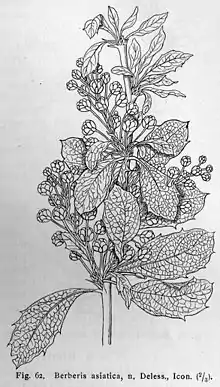Berberis asiatica
Berberis asiatica (Indian or Asian barberry), is a species of shrub, in the family Berberidaceae. It is native to the Himalayas (East and West Himalaya), India (including Himachal Pradesh region), Bangladesh, Myanmar, Nepal and Tibet.[1]
| Berberis asiatica | |
|---|---|
 | |
| Illustration of Berberis asiatica from the book Handbuch der Laubholzkunde from 1889 by Dr. Leopold Dippel | |
| Scientific classification | |
| Kingdom: | Plantae |
| Clade: | Tracheophytes |
| Clade: | Angiosperms |
| Clade: | Eudicots |
| Order: | Ranunculales |
| Family: | Berberidaceae |
| Genus: | Berberis |
| Species: | B. asiatica |
| Binomial name | |
| Berberis asiatica | |
| Synonyms[1][2] | |
| |
It is found in subtropical to temperate regions,[3] and at altitudes of 600–2,700 m (1,968.5–8,858.3 ft) above sea level.[4]
B. asiatica is an upright, spiny and glabrous bush. It has blood-red coloured fruit.[4]
It was first published in Syst. Nat. 2: 13 in 1821.[1] The name has been verified by United States Department of Agriculture and the Agricultural Research Service on 2 January 2003.[5]
Its fruit has potential nutraceutical values. Extracts from the fruit possesses a potential source of polyphenolic, mainly anthocyanin compounds, which can be used for treating inflammation diseases (Neag et al. 2018).[6]
References
- "Berberis asiatica Roxb. ex DC". Retrieved 16 October 2023.
- "Berberis asiatica Roxb. ex DC". Retrieved 16 October 2023.
- Shri, K.S.; Sharma, Y.P.; Pankaj, S.; Pratima, V.; Randhawa, S.S. (2018). "Wild edible fruits of Himachal Pradesh state centre on climate change & UNEP-GEF-MoEFCC project report" (PDF).
- Bachheti, Archana; Deepti; Bachheti, Rakesh Kumar; Singh, Anjita; Zebeaman, Meseret; Hunde, Yilma; Husen, Azamal (2023). "Bioactive constituents and health promoting compounds of underutilized fruits of the northern Himalayas of India: a review". Food Production, Processing and Nutrition. 5 (24). doi:10.1186/s43014-023-00140-5.
- "Berberis asiatica". Germplasm Resources Information Network. Agricultural Research Service, United States Department of Agriculture. Retrieved 16 October 2023.
- Neag, M.A.; Mocan, A.; Echeverría, J.; Pop, R.M.; Bocsan, C.I.; Crişan, G.; Buzoianu, A.D. (2018). "Berberine: Botanical occurrence, traditional uses, extraction methods, and relevance in cardiovascular, metabolic, hepatic, and renal disorders". Frontiers in Pharmacology. 9: 557. doi:10.3389/fphar.2018.00557. PMC 6111450. PMID 30186157.
Other sources
- Council of Scientific and Industrial Research, India. 1988. The wealth of India: a dictionary of Indian raw materials and industrial products. Raw materials (revised edition). 2:114-117.
- Council of Scientific and Industrial Research, India. 2000. The wealth of India: a dictionary of Indian raw materials and industrial products. First supplementary series (raw materials). New Delhi 1:135.
- Grierson, A. J. C. & D. J. Long. 1984-. Flora of Bhutan including a record of plants from Sikkim.
- Hara, H. et al. 1978-1982. An enumeration of the flowering plants of Nepal.
- Huxley, A., ed. 1992. The new Royal Horticultural Society dictionary of gardening
- Sharma, B. D. et al., eds. 1993-. Flora of India.
- Walters, S. M. et al., eds. 1986-2000. European garden flora.